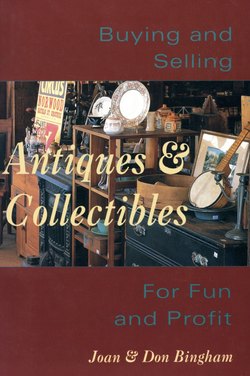Читать книгу Buying & Selling Antiques & Collectibl - Don Bingham - Страница 7
На сайте Литреса книга снята с продажи.
ОглавлениеIntroduction
We're often asked how we happened to get into the business of buying and selling antiques and collectibles. The truth is, we started doing this as a hobby. We are, and have been all of our adult lives, writers. And writing is a solitary profession. Both of us felt the need to get out into the world more. After all, we do like people.
A good friend, who's an antiques dealer, suggested we attend a few auctions... just for the fun of it and because we like antiques and were, at that time, looking for furniture and accessories for our home. We took the advice and went to auctions, we saw lots of merchandise, we bought things for our house, and we thoroughly enjoyed ourselves. The only trouble was we had soon purchased everything we needed, and we still wanted to go to auctions. "Well," our friend said, "Why don't you go into the business?"
After a bit of discussion, we decided it was worth a try. We might not make money at it, but we would have fun, and we could continue to attend the auctions we had grown to love. Our initial efforts at purchasing inventory were not always successful. Before we started in business, we purchased only those things that we personally wanted to own. But once we were in business, we knew we had to get merchandise that would appeal to a variety of people.
Certain names and items were familiar to us— Limoges, Bradley and Hubbard, and Tiffany, for example. When an item came up at auction that bore one of those familiar names, we'd bid and more often than not we'd take the item in question home—delighted with our purchase and with our knowledge. It didn't take us long to discover that Limoges (or any china) with a transfer pattern is generally worth far less than it would be if the design were handpainted. We then bid on everything we saw that was handpainted only to discover that some handpainted articles were well done and others were not, and that pieces handpainted at the factory were almost always nicer than those done by a hobbiest. We found that the name Bradley and Hubbard was a good one and did help sell an item. But we also found that articles with missing pieces were slow sellers even if they were by Bradley and Hubbard. And Tiffany—that wonderful name—it wasn't long before we discovered that most Tiffany on the market today is Tiffany type, and that anything actually done by Louis Comfort Tiffany was well out of our price range.
We continued to learn, and we found to our surprise that we were making a profit. Not a large one at first. But a profit nonetheless. We found that we did best and were happiest selling a variety of merchandise with a wide price range. We also discovered garage sales, flea markets, tag sales, and estate sales were viable markets for purchasing articles to sell, although we confess we've never enjoyed this type of shopping as much as auctions.
Our little hobby was turning into a lucrative business. We found we looked forward to our selling days. We made friends with other dealers and with customers. But most of all we were and are having fun buying and selling antiques and collectibles. We hope you do too!
